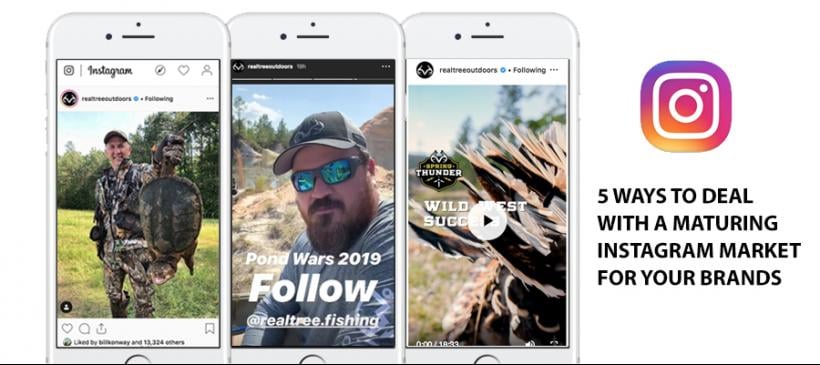5 Ways to Deal with a Maturing Instagram Market for Your Brands
- May 8, 2019
- By Adam Preston
- Marketing

It’s hard to believe, but Instagram started barely eight years ago. No one really knew what to expect when this platform opened for business on Oct. 6, 2010, but 25,000 members signed up almost instantly. The founders knew they were onto something, but little did they know of the potential marketing monster they had unleashed.
By 2015, there were 77.5 million users. That number is expected to exceed 111 million by the end of this year. Pretty impressive numbers, no doubt, but they pale in comparison to Facebook’s estimated 1 billion users. If that’s the case, how could Instagram be viewed as a “maturing market?” The answer can be summed up in three words: painfully slow growth.
Just like any other social media platform, early Instagram users found it quite easy to build large followings rather fast. It’s similar to early search engine optimization — the pickings were easy until everyone started doing it and Google lowered the boom with new rules and algorithm changes.
However, just because things are changing doesn’t mean you can’t still take advantage of the system. You just have to work a little smarter. With that in mind, let’s take a look at five things you can do right now to deal with this maturing social media market when it comes to extending your brand’s reach.
1. Dump the Pay and Pray Approach
Whether you’re paying social media partners in dollars or product, a top priority for 2019 is to dump the “we hope this works” approach. If it is working for you, I highly doubt that you’re reading this blog post, because I don’t know of anyone who is enjoying much success with it in any social media platform, to be honest.
This is marketing in today’s day and age. These new platforms allowed for the wait-and-see approach mainly because initial algorithms encouraged them. It’s not that the developers were oblivious – it’s actually the opposite – they knew exactly what they were doing. To get the platforms up and running at robust rates, it was pretty much the Wild West for users.
In many respects it was, “Post as much content as humanly possible, and we’ll reward you with large follower bases.” The game has now changed simply because a lot of money is changing hands, and the platforms want more of it (obviously) and they want to ensure their platforms aren’t just one big sales tool for everyone. We will dive into that more in a moment.
2. Invest in Authenticity
Social media as a whole is inflated with a lot of fakers, and we’re not just talking about rank amateurs pretending to be something they’re not. Inauthenticity stretches the gamut and includes everything from fake followers, engagement rates and, yes, celebrity wannabes. Identifying the latter is fairly easy, especially in the outdoors industry, but even in the case of a quasi-legitimate individual, you need to be sure they are delivering what you’re paying for if you’re employing them as a brand ambassador.
Up until December 2018, individuals and brands found success on Instagram not only by buying likes but also engagement. That changed suddenly halfway through the month when Instagram installed programs that disabled third-party tools that allowed users to auto-follow, auto-like and auto-comment on their profiles, posts and stories. Engagement rates plummeted by more than 90 percent for the Top 500 Instagram accounts (overall). Just imagine what it did for the seemingly endless 100K fan pages of outdoors “influencers” that you had never heard of before joining Instagram.
Does this mean you should give up on large-base accounts entirely? No. Just approach them with extreme caution, and demand real-time analytics, quarterly analytics, and a detailed posting plan. According to analytics platform TalkWalker, there is a clear frustration with the lack of professionalism of Instagram influencers, which often focus on the short-term gratification rather than forging long-term relationships with the brands they represent.
The advice I would give anyone who is doubling down on influencer media is to assemble a portfolio that includes a good cross-section of up-and-comers, mid-level experts and partnerships with existing and complementary brands. This approach not only provides depth and breadth to your efforts, it also provides accountability to analytics acquisition.
3. Clearly Define Influencer Challenges and Goals
In another TalkWalker study, brands were asked to identify the top challenges they encounter when dealing with influencers. The Top 5 challenges they listed could easily translate to mission statement goals that you can include in revised social media contracts:
• Ability to measure the return on investment of an influencer partnership and/or campaign.
• Ability to identify influencers who could be true game-changers.
• Ability to creatively collaborate with influencers.
• Ability to develop a lasting relationship with influencers.
• Ability to manage the day-to-day activities of influencers.
The most startling statistic from the TW study was that more than one-third of the companies (38 percent) said they had no mechanism by which to gauge an influencer’s ROI for their brands. That’s beyond sobering, and the hunch here is that this percentage is much higher (perhaps twice as high?) in the outdoors industry.
The take-home message: If you’re paying influencers simply because they like to live an outdoors experience, you’re taking a big gamble on whether or not it’s putting top-line revenue back on your books.
4. Set a Specific Budget
How much you spend on Instagram influencer marketing really depends on the size and scope of your business. But in a maturing market, it is absolutely critical to set a budget and stick with it for a determined timespan. Whether it’s a fiscal quarter, year or even just one campaign, how much you spend will allow you to better gauge your ROI and make strategy adjustments moving forward.
Interestingly, more than 60 percent of all companies using Instagram influencers spend more than $2,000 annually, and nearly a quarter (24 percent) spend more than $30,000. That trend isn’t going away anytime soon. In 2019, 62 percent of all companies said they expected to spend “moderately more” on brand influencers.
How much should you pay? Some PR experts suggest annual partnerships with a flat rate. Others suggest a standard cost-per-thousand of an influencer’s fan base. Still others say a modest CPT of the actual engagements. The happy medium might be a combination of all three formulas spread out via a synergy chart of influencers from all levels of Instagram “stardom.”
5. Stay on Top of Things with Dedicated Management
If you stopped reading there, you might think that everyone is shooting in the dark. On one hand, the maturing market poses many challenges and obstacles. On the other hand, everyone expects to spend a lot more money doing it (at least in the near future). The silver lining to these mixed messages is reserved for those who truly “get it.” They key here is to be on top of things to the point where you have a clear understanding of either a) enough is enough, b) you need to take a new direction, and/or c) a mid-course shuffle is necessary.
To stay on top of these concerns and spend budgets wisely, smart brands either hire an agency to manage the process or (as is most often the case with outdoors brands) they appoint an internal employee to manage influencer budgets, activity and brand messaging. According to one study, 72 percent of all Instagram brands employ one or more dedicated employees to influencer marketing; 10 percent outsource the management process; while 2 percent said they are in the process of hiring someone. The remaining 16 percent do not manage it, nor do they plan on hiring anyone to do it for them.
It’s just a guess, but those 16 percent probably aren’t monetizing anything when it comes to their Instagram platforms.
Closing Thoughts
Instagram is and will be a positive force for outdoors industry marketers. This visual platform has kept pace with technology and has also maintained the attention span of the coveted young American consumer base. If you want maximum return from your marketing dollars, understand not only how the platform work but also how its maturing tendencies will require constant monitoring.
Editor’s Note: Here at the Realtree Business Blog, we want to help your outdoors business succeed! For more insights into navigating the ever-changing online business landscape, check out our recent post on using social media to drive e-commerce.
Want to Learn More?
- 5 Ways to Deal with a Maturing Instagram Market for Your Outdoor Brands
- HOW to use social media to drive Ecommerce
- IGTV Hoping to Win Big
- Sell More with “Shoppable” Instagram Posts
- Introducing Realtree United Hunting Properties
- Behold the Power of ChatBots
- 3 Trends Among Urban Hunters Will Surprise You
- 5 things you should know before hiring Social Ambassadors for Your Brand
- 5 Things You Must Know About Social Media Messaging
- Realtree Fishing Gears Up for Orlando ICAST Trade Show
